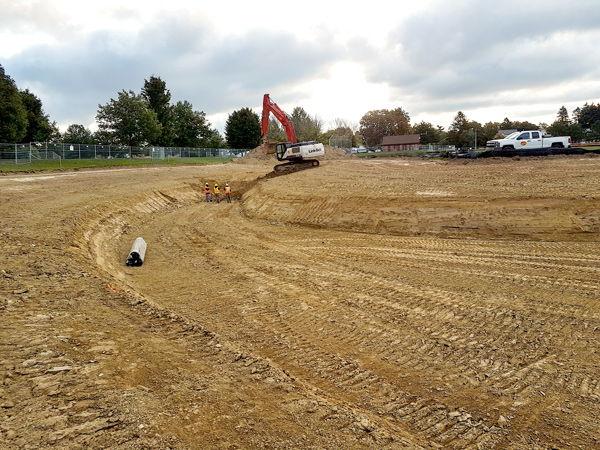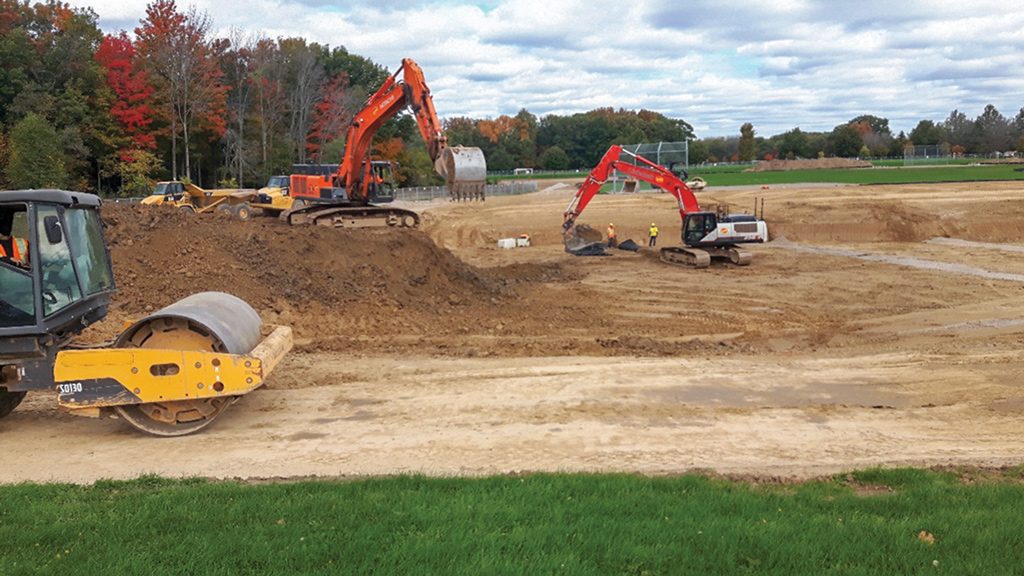Surrounded by a natural woodlot, ravine lands and the Cootes Paradise marsh, Hamilton’s popular Churchill Park has been the site of a massive earth movement and trucking operation which resulted in a partial closure of the park last August.
But by June the low impact and relatively inexpensive project, which will usher a number of environmental benefits, is expected to be completed and the closed area reopened.
Undertaken by Brampton-based Metric Contracting Services, the $1.45-million project encompasses the excavation/construction of two rain gardens comprised of shallow above-grade dry ponds, each with large below-grade stormwater storage basins. The larger pond is equipped with a 4,300-square-metre (46,284 square-feet) basin and the second basin is 1,200 square metres (12,916 square feet) in size.
Designed by WSP Canada Inc., the garden system will relieve pressure on an at-capacity combined sewer system in adjacent residential areas, reduce the risk of basement flooding in the homes, and address drainage issues in the park itself.
Located in the south-end of the park, which is owned by the Royal Botanical Gardens and managed by the City of Hamilton, the rain gardens are intended to accommodate a 100-year storm, says project manager and city landscape architect Ken Wheaton.
Consisting of a range of levels with different materials such a 19-mm clear stone, a high draining soil filter media, a non-woven geotextile layer, and a clear stone “choke layer”, the 1.45-metre-deep storage basins will retain the stormwater until it has a chance to filter through and into the ground. The choke layer is particularly effective in slowing and filtering the water, says Wheaton.
Below the basins is a network of 12- to 52-metre-long (129 to 559-foot) trenches (21 in total) which will disperse the water through a coarse layer of sand which extends across the site at varying depths.
“In large storms, there will be some surface ponding, but the system is designed to reduce the time that water stays on the surface of the ponds.”
Site topography, existing baseball diamonds, and existing drainage catchment areas were some of the factors which determined the specific location of the gardens and why there are two. The larger garden includes an external catchment area along Parkside Drive, while the second will drain two baseball diamonds and a small portion of the park, Wheaton says.
Planning for the project began in 2010 under a master plan and management process which is regulated by the Niagara Escarpment Plan. Dillon Consulting Ltd. was the consultant for the plan which identified a series of “short, medium, and long-term” improvements such as adding forest cover.
A separate parallel plan was also undertaken in 2012 to review stormwater management in the park, plus basement flooding in some areas of the nearby Westdale community.
Many possible solutions were looked at in the 2012 stormwater study, including capital replacement and upsizing of sewer pipes. But the rain garden project was ultimately chosen as the preferred environmental solution, especially as the park was close to the residential areas, he says.

Detailed design by WSP Canada began in 2013 and was completed last year, with a tender being awarded in May and construction starting in August.
Using several different pieces of heavy equipment, Metric excavated 28,000 cubic metres (988,810 cubic feet) of earth, placed 19,000 tonnes of aggregate for the storage basins, as well as installing the various filtering levels.
The excavated soil, which was tested and conformed to Ministry of the Environment and Climate Change (MOECC) Table 1 soil standards criteria, was trucked to two local City of Hamilton construction projects to be used as fill, says Wheaton.
A number of measures were implemented to protect Cootes Paradise — a UNESCO World Biosphere Reserve — the woodlot, and the rest of the park, he points out.
For example, silt sacks were inserted in the surrounding catch basins, a silt fence was installed around the entire perimeter of the site, and a 20-metre-long (65-foot) mud mat was installed at the access site to reduce mud-tracking from vehicles entering and exiting the site, he says.
Construction continued until last November. The plan is for Metric to return to the site later this spring — after the muddy conditions have cleared — to complete the final phases including building adjacent gravel pathways, and sodding and seeding the ponds with native seed cover. In about a year they will have transformed into naturalized wildflower areas.
Planning for a second phase rain garden in another section of the park is already underway, says Wheaton.




Recent Comments